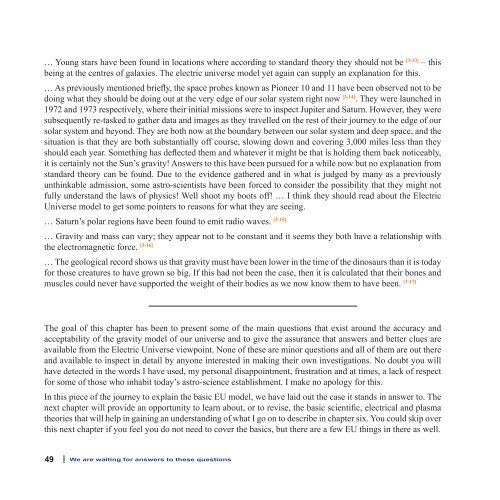A Beginner's View of Our Electric Universe - New
A Beginner's View of Our Electric Universe - New
A Beginner's View of Our Electric Universe - New
Create successful ePaper yourself
Turn your PDF publications into a flip-book with our unique Google optimized e-Paper software.
… Young stars have been found in locations where according to standard theory they should not be [3-13] – this<br />
being at the centres <strong>of</strong> galaxies. The electric universe model yet again can supply an explanation for this.<br />
… As previously mentioned briefly, the space probes known as Pioneer 10 and 11 have been observed not to be<br />
doing what they should be doing out at the very edge <strong>of</strong> our solar system right now [3-14] . They were launched in<br />
1972 and 1973 respectively, where their initial missions were to inspect Jupiter and Saturn. However, they were<br />
subsequently re-tasked to gather data and images as they travelled on the rest <strong>of</strong> their journey to the edge <strong>of</strong> our<br />
solar system and beyond. They are both now at the boundary between our solar system and deep space, and the<br />
situation is that they are both substantially <strong>of</strong>f course, slowing down and covering 3,000 miles less than they<br />
should each year. Something has deflected them and whatever it might be that is holding them back noticeably,<br />
it is certainly not the Sun’s gravity! Answers to this have been pursued for a while now but no explanation from<br />
standard theory can be found. Due to the evidence gathered and in what is judged by many as a previously<br />
unthinkable admission, some astro-scientists have been forced to consider the possibility that they might not<br />
fully understand the laws <strong>of</strong> physics! Well shoot my boots <strong>of</strong>f! … I think they should read about the <strong>Electric</strong><br />
<strong>Universe</strong> model to get some pointers to reasons for what they are seeing.<br />
… Saturn’s polar regions have been found to emit radio waves. [3-15]<br />
… Gravity and mass can vary; they appear not to be constant and it seems they both have a relationship with<br />
the electromagnetic force. [3-16]<br />
… The geological record shows us that gravity must have been lower in the time <strong>of</strong> the dinosaurs than it is today<br />
for those creatures to have grown so big. If this had not been the case, then it is calculated that their bones and<br />
muscles could never have supported the weight <strong>of</strong> their bodies as we now know them to have been. [3-17]<br />
The goal <strong>of</strong> this chapter has been to present some <strong>of</strong> the main questions that exist around the accuracy and<br />
acceptability <strong>of</strong> the gravity model <strong>of</strong> our universe and to give the assurance that answers and better clues are<br />
available from the <strong>Electric</strong> <strong>Universe</strong> viewpoint. None <strong>of</strong> these are minor questions and all <strong>of</strong> them are out there<br />
and available to inspect in detail by anyone interested in making their own investigations. No doubt you will<br />
have detected in the words I have used, my personal disappointment, frustration and at times, a lack <strong>of</strong> respect<br />
for some <strong>of</strong> those who inhabit today’s astro-science establishment. I make no apology for this.<br />
In this piece <strong>of</strong> the journey to explain the basic EU model, we have laid out the case it stands in answer to. The<br />
next chapter will provide an opportunity to learn about, or to revise, the basic scientific, electrical and plasma<br />
theories that will help in gaining an understanding <strong>of</strong> what I go on to describe in chapter six. You could skip over<br />
this next chapter if you feel you do not need to cover the basics, but there are a few EU things in there as well.<br />
4 | We are waiting for answers to these questions


